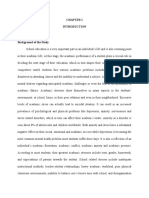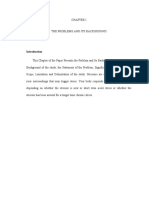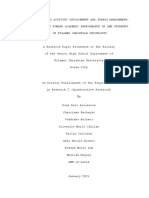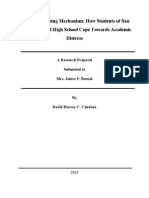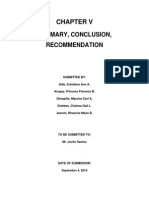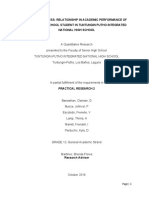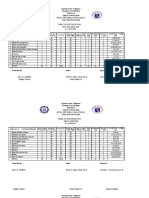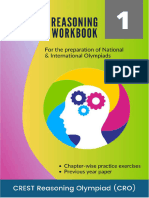Formal
Formal
Uploaded by
Erni LatogaCopyright:
Available Formats
Formal
Formal
Uploaded by
Erni LatogaOriginal Title
Copyright
Available Formats
Share this document
Did you find this document useful?
Is this content inappropriate?
Copyright:
Available Formats
Formal
Formal
Uploaded by
Erni LatogaCopyright:
Available Formats
COPING MECHANISM OF STRESS AMONG GRADE 12
SENIOR HIGH SCHOOL STUDENTS OF PILAR
NATIONAL COMPREHENSIVE HIGH SCHOOL
S.Y 2022 - 2023
Alondra A. Cambi
Erni L. Latoga
Trixie L. Lumbao
Lovely M. Flores
Renel M. Carullo
INTRODUCTION
Stress and coping with stress are phenomena closely intertwined with
human life. They relate to all minor and major events in life. Even in our
day to day life, stress is the topic of many conversations, people talk
about the stress of balancing home and work life, the stress of being hard
pressed for time, of living in a mechanical society, We also come across
people who seek to reduce this stress by going to yoga therapies.
STATEMENT OF THE PROBLEM
1. What are the stress factors affecting the Senior High
School student in PNCHS?
2. What are the effects of stress in the a
performance among the students?
3. What are the ways or method to cope with
the stress?
SIGNIFICANCE OF THE STUDY
Chapter 1
Chapter 2
• DepEd
Chapter 3 • Teachers
• Students
Chapter 4
• Parents
Chapter 5 • Researchers
• Future Researchers
THEORETICAL FRAMEWORK
Chapter 1 • James-Lange: Theory of Emotion - William James and Carl Lange said
emotions do not immediately succeed the perception of the stressor or the
stressful event; they become present after the body’s response to the stress.
Chapter 2
• Cannon-Bard: The Emergency Theory - This theory is quite the opposite of
Chapter 3
what James and Lange proposed. According to theorist Walter Cannon,
emotion in response to stress can actually occur even when the bodily changes
Chapter 4 are not present.
Chapter 5 • The Schachter-Singer Theory - This theory explains that we become aware of
the reason behind the emotional response, and when we the reason is not
obvious, we start to look for environmental clues for the proper interpretation
of the emotion to occur.
THEORETICAL PARADIGM
Chapter 1
Chapter 2
Chapter 3
Chapter 4
Chapter 5
CONCEPTUAL PARADIGM
INPUT PROCESS OUTPUT
Chapter 1
• Data collection of
Chapter 2 • What are the stress students response • Identified the stress
factors affecting the through survey factors affecting the
senior high school questionnaires. Senior High School
Chapter 3 students in PNCHS? students and their
• Organized academic performance.
• What are the effects of questionnaires
Chapter 4 stress in the academic • Presented the
• Organized students difficulties and
performance among the
students? responses problems found by the
Chapter 5 students.
• What the ways or • Statistical analysis of
method to cope with the data • Enumerated the
stress? coping strategies that
the respondents are
making.
RESEARCH DESIGN
This study used quantitative type of research which is Survey
Research Design. It is defined as a systematic investigation of
phenomena by gathering quantifiable data in performing statistical
techniques. Furthermore, it collects information from existing and
potential customers using sampling method and survey questionnaires.
RESPONDENTS/PARTICIPANTS
OF THE STUDY
The respondents of the study are fifty (50) of Senior High School
students in Pilar National Comprehensive High School. A simple random
sampling is a randomly selected subset of a population, by this sampling
method, each member of the population has an exactly equal chance of
being selected.
INSTRUMENT OF THE STUDY
In this study, Researchers utilized the survey questionnaire that will
be conducted through survey to gathered the data needed and identify the
stress factors of the respondents and their coping strategies. A survey
questionnaire is a research instrument that consist of a set of a questions
to collect information from the respondents. It is used to collect data from
a defined group of respondents information to gain info’s and insight of
various topics of interest.
STATISTICAL TREATMENT
In the data processing of this study are the following; The permission
to conduct the study, brainstorming and focal group discussion
formulating the survey questionnaire, analysis and interpret the data
gathered.
Formula ;
F = frequency
T = total no. of the respondents
P = percentage
ANALYSIS OF DATA
I. Stress Factors Affecting You
The table shows that the highest stress factors that is experienced
by the respondents is Financial Problem with the frequency count of
15 and with the percentage of 30 and Experiencing Discrimination,
Returning to Study, Distracted Mind, Unhealthy Lifestyle and Loss
of interest has the lowest frequency count of 1 with the percentage
of 2.
INTERPRETATION OF DATA
Students noted that not having enough money to participate in the same
activities as peers and expecting to have higher amounts of student loan
debt at graduation. Thus, students may feel embarrassed that they cannot
afford the same things as their peers and/or are unable to socialize to the
same extent. Students may also feel guilty, anxious and unable to help
their parents deal with their situation this also has an impact on their
confidence and feeling of self-worth.
DISCUSSION OF DATA
Based on the study of Halliday Wynes (2014), a student financial
position will affect their academic performance. Moreover, due to
inflation and trade war, it had made most of the country facing recession
and increase the cases of student facing financial problem. In contrast,
some have to work to self-finance their education and essential daily
necessities. It was also stated by Daud et al. (2018) that some students do
not have other financial resources. They do not have any savings.
ANALYSIS OF DATA
The table reveals that Late Submission is the effect of stress in academic
performance that has the highest frequency count of 13 with the
percentage of 26 and School Drop outs and Strained Relationship has the
lowest frequency count of 1 with the percentage of 2
INTERPRETATION OF DATA
The researchers found that late submission of homework was the
highest effects of stress in the Academic Performance which has 13
respondents means students are not able to meet their developmental needs
or cultivate other critical life skills at the same time. In other words,
students are more likely to give up extracurricular activities, spend less
time with friends and family, and stop pursuing their hobbies. In the
survey, the researchers asked students the effects of stress in the Academic
Performance they experienced.
DISCUSSION OF DATA
The study of Falkner (2012) found that assignment submission patterns
could be an indicator for identifying at-risk students and increased rate of
course withdrawals at an institution. Several studies show a correlation
between student procrastination and academic performance and according
to Nordby et al., (2017). Procrastination can lead to missed classes,
assignments, and result in lower grades. Additionally, the quality and
accuracy of work can be reduced due to the pressure associated with
completing an assignment on a crunched timeline Kim & Seo., (2015).
ANALYSIS OF DATA
The table shows that according to the respondents the best coping
mechanism that they do is Listening to Music with a frequency count of 9
with the percentage of 18 and Meditation and Board games has the lowest
with frequency count of 1 with the percentage of 2.
INTERPRETATION OF DATA
Students noted that the use of music to cope with stress is an example of
an emotion-focused, adaptive coping strategy. Rather than focusing on the
stressor itself, music therapy is typically geared towards reducing or
eliminating the emotions that arise in response to stress. Music can reduce
stress it has long been suggested that music can help reduce or manage
stress. Consider the trend centered on meditative music created to soothe
the mind and inducing relaxation. Fortunately, this is one trend supported
by research. Listening to music can be an effective way to cope with stress.
DISCUSSION OF DATA
The study of Thompson, Samuel Harvey, also stated that the stress
experienced by students and their means of coping with stress were
examined through verbal descriptions of daily college stressors and
accompanying coping mechanisms. The goal was to reveal the leisure
activity of listening to music as a dominant coping mechanism used by
college students. To calm themselves down from the stress of schoolwork,
exams, and relationships, students cited listening to music as a coping
mechanism more than any other activity.
FINDINGS
1. 15 out of 50 respondents answered "financial problems" as the stress
factors that affect them with a percentage of 30.
2. This study shows that 15 out of 50 respondents answered " late
submission of homework " is the highest effects in academic performance
of the students of the respondents with 26%.
3. Based on the collected data 9 out 50 respondents answered "listening to
music" serve as their coping mechanism with a percentage of 18.
CONCLUSION
1. Based on the results the majority of the respondents answered “financial
problems”. Therefore, students can’t attend classes because of lack in
allowance.
2. Based on the the findings presented, it is concluded that the majority of
the respondents answered “late submission of homework” that resulted
students having/attaining a low or a failing grade.
3. Based on the the findings presented, it is concluded that the majority of
the respondents cope up with their stress through listening to music.
RECOMMENDATION
1. They should find a part time job to make a profit in order to support
their financial needs.
2. Pay more attention in class and improve time management and stay
focused when doing school activities and always study.
3. Take a rest and listen to music it can lighten up your mood and it will
help to clear your mind and it can reduce anxiety and it also improve
mental alertness that will help you to reduce the stress.
INTRODUCTION
Background of Statement of
Objectives
the Study the Problems
Chapter 1
Chapter 2
• Objective 1
Chapter 3
• Objective 2
Chapter 4
• Objective 3
Chapter 5
• Objective 4
REVIEW OF RELATED
LITERATURE AND STUDIES
Chapter 1
Chapter 2
Chapter 3
Chapter 4
Chapter 5
METHODOLOGY
Chapter 1 Insert Process Here Insert Process Here
Chapter 2
Chapter 3
Chapter 4 Insert Process Here Insert Process Here
Chapter 5
Insert Process Here Insert Process Here
RESULTS AND DISCUSSION
Results Discussions
Chapter 1
Sample Table
Chapter 2
Chapter 3 Category 4
Chapter 4 Category 3
Chapter 5
Category 2
Category 1
0 2 4 6 8 10 12 14
Series 1 Series 2 Series 3
RESULTS AND DISCUSSION
Results Discussions
Chapter 1
Chapter 2 Lorem ipsum dolor sit amet, consectetuer adipiscing elit.
Maecenas porttitor congue massa. Fusce posuere, magna sed
Chapter 3 pulvinar ultricies, purus lectus malesuada libero, sit amet
commodo magna eros quis urna.
Chapter 4
Lorem ipsum dolor sit amet, consectetuer adipiscing elit.
Chapter 5 Maecenas porttitor congue massa. Fusce posuere, magna sed
pulvinar ultricies, purus lectus malesuada libero, sit amet
commodo magna eros quis urna.
SUMMARY, CONCLUSIONS,
AND RECOMMENDATIONS
Chapter 1
Chapter 2
Summary
Chapter 3 Lorem ipsum dolor sit amet,
consectetuer adipiscing elit. Maecenas
Chapter 4 porttitor congue massa. Fusce posuere,
Conclusions magna sed pulvinar ultricies, purus lectus
malesuada libero, sit amet commodo magna
Chapter 5
eros quis urna.
Recommendations
SUMMARY, CONCLUSIONS,
AND RECOMMENDATIONS
Chapter 1
Chapter 2
Summary
Chapter 3 Lorem ipsum dolor sit amet,
consectetuer adipiscing elit. Maecenas
Chapter 4 porttitor congue massa. Fusce posuere,
Conclusions magna sed pulvinar ultricies, purus lectus
malesuada libero, sit amet commodo magna
Chapter 5
eros quis urna.
Recommendations
SUMMARY, CONCLUSIONS,
AND RECOMMENDATIONS
Chapter 1
Chapter 2
Summary
Chapter 3 Lorem ipsum dolor sit amet,
consectetuer adipiscing elit. Maecenas
Chapter 4 porttitor congue massa. Fusce posuere,
Conclusions magna sed pulvinar ultricies, purus lectus
malesuada libero, sit amet commodo magna
Chapter 5
eros quis urna.
Recommendations
THANK YOU
You might also like
- NeurodharmaDocument39 pagesNeurodharmacellochiquini67% (6)
- Research SELF ESTEEM Grp4. 3Document59 pagesResearch SELF ESTEEM Grp4. 3Katrina CaveNo ratings yet
- Review of Related Literatures and Studies LLLLDocument17 pagesReview of Related Literatures and Studies LLLLreynald salva95% (19)
- ResearchDocument13 pagesResearchMarion Joy GanayoNo ratings yet
- Research FinalDocument41 pagesResearch FinalShang AntonioNo ratings yet
- DefenseDocument33 pagesDefenseAustin Kelly RamillanoNo ratings yet
- The Study of Stress Management On Academic Success ofDocument11 pagesThe Study of Stress Management On Academic Success ofErwin llabon0% (1)
- The Effect of Depression in Student's Academic Performances in SchoolDocument26 pagesThe Effect of Depression in Student's Academic Performances in SchoolhinehilarioNo ratings yet
- Thesis CHAPTER IDocument12 pagesThesis CHAPTER IKyla Mae Ulat100% (1)
- Effects of AnxietyDocument4 pagesEffects of AnxietyEdelrose LapitanNo ratings yet
- Levels of Academic Stress Among Senior High School Scholar Students of The Mabini AcademyDocument18 pagesLevels of Academic Stress Among Senior High School Scholar Students of The Mabini AcademyRaymond Lomerio100% (2)
- Group 1 ArchimedesDocument19 pagesGroup 1 ArchimedesRada JulailiNo ratings yet
- Related Studies Local 1Document7 pagesRelated Studies Local 1CAMILLE CASAJENo ratings yet
- ResearchDocument22 pagesResearchGwen Marie CerenioNo ratings yet
- PR - Oplimo Academic Pressure and Its Implication On Mental HealthDocument35 pagesPR - Oplimo Academic Pressure and Its Implication On Mental HealthkentmichaeloplimoNo ratings yet
- Chapter I III PracResearch2FINALDocument17 pagesChapter I III PracResearch2FINALjanicajemimah.00No ratings yet
- Chapter I, Ii and IiiDocument32 pagesChapter I, Ii and IiiNUÑEZ, BIANCA G.No ratings yet
- Background of The StudyDocument7 pagesBackground of The StudySkadirt CreepsNo ratings yet
- Causes and Negative Impacts of StressDocument24 pagesCauses and Negative Impacts of StressAngela Dela Merced RugayanNo ratings yet
- E04513236 PDFDocument5 pagesE04513236 PDFJohnjohn MateoNo ratings yet
- Republic of The Philippines Nueva Ecija University of Science and Technology Cabanatuan CityDocument13 pagesRepublic of The Philippines Nueva Ecija University of Science and Technology Cabanatuan CityJohn Paul GioketoNo ratings yet
- Title DefenseDocument15 pagesTitle Defensealtea puyoNo ratings yet
- Stress and Coping Mechanism of Selected Senior High School Students of Saint Augustine School A.Y. 2017-2018Document8 pagesStress and Coping Mechanism of Selected Senior High School Students of Saint Augustine School A.Y. 2017-2018JAN RONNIE SIDAMONNo ratings yet
- B9-Coping MechanismDocument11 pagesB9-Coping MechanismAnabelle LagulosNo ratings yet
- Group 4 Chapter 1 3 NewDocument50 pagesGroup 4 Chapter 1 3 NewIan Kenneth LimNo ratings yet
- PR1 SampleDocument77 pagesPR1 SampleRussell Von DomingoNo ratings yet
- Philippine Tong Ho Institute, IncDocument43 pagesPhilippine Tong Ho Institute, IncMy Cryptic fandomNo ratings yet
- The Psychological Effects of Vices Towards Academic Output Among Selected Senior High SchoolDocument57 pagesThe Psychological Effects of Vices Towards Academic Output Among Selected Senior High SchoolCris Mark Flores RoselloNo ratings yet
- Action Research PaperDocument4 pagesAction Research PaperMylei ColisaoNo ratings yet
- IMRAD Final RevisedDocument11 pagesIMRAD Final RevisedLyle PadilloNo ratings yet
- Effects of Subject With Research ComponentsDocument10 pagesEffects of Subject With Research ComponentsAgripino SandingNo ratings yet
- Quantitative Study On Students Stressors and Its Impact To Academic Performance Among Grade 11 Students of Sta. Ana National Senior High SchoolDocument21 pagesQuantitative Study On Students Stressors and Its Impact To Academic Performance Among Grade 11 Students of Sta. Ana National Senior High SchoolAnalyn DominguezNo ratings yet
- Synopsis FormatDocument23 pagesSynopsis FormatShreyas WalvekarNo ratings yet
- StreditDocument6 pagesStreditstephanie grace canonceNo ratings yet
- Final Thesis JohaiberDocument30 pagesFinal Thesis JohaiberHassan GandamraNo ratings yet
- PR PrintDocument17 pagesPR PrintJushrhey YulasNo ratings yet
- PR PrintDocument27 pagesPR PrintJushrhey YulasNo ratings yet
- Chapter 1 PatternDocument41 pagesChapter 1 PatternJaime SorianoNo ratings yet
- Chapter 1 and 2 (LATEST)Document34 pagesChapter 1 and 2 (LATEST)Jade MonteverosNo ratings yet
- Suicide and Its Relationship To The Stress and Anxiety Rate of An Individual 1 1Document18 pagesSuicide and Its Relationship To The Stress and Anxiety Rate of An Individual 1 1dmhikhaleNo ratings yet
- Chapter 5Document5 pagesChapter 5KrislynAnnNo ratings yet
- RESEARCH PROPOSAL BASAS JMDNKCMDocument11 pagesRESEARCH PROPOSAL BASAS JMDNKCMNathan RodriguezNo ratings yet
- Chapter 1 Group 12 1Document7 pagesChapter 1 Group 12 1Net netNo ratings yet
- Academic Stress in SHS of TPINHS and Their Academic PerformanceDocument28 pagesAcademic Stress in SHS of TPINHS and Their Academic PerformanceJohncel Palomata BuezaNo ratings yet
- The Impact of Anxiety To StudentsDocument50 pagesThe Impact of Anxiety To StudentsErika Carranza100% (2)
- Introduction To Psychology: Final Report: "Stress Taken by Students."Document9 pagesIntroduction To Psychology: Final Report: "Stress Taken by Students."Haider AbbasNo ratings yet
- Research SELF ESTEEM Grp4. 3Document59 pagesResearch SELF ESTEEM Grp4. 3Katrina CaveNo ratings yet
- Research Proposal 2Document12 pagesResearch Proposal 2Sean Gil amosNo ratings yet
- Chapter 1 Pr2Document7 pagesChapter 1 Pr2John Mark Callanga CalmaNo ratings yet
- The Negative Impact of Stress in Academic Performance To StudentsDocument9 pagesThe Negative Impact of Stress in Academic Performance To StudentsPaolo MiguelNo ratings yet
- Jenjen Done.Document26 pagesJenjen Done.CCS Senator -Abogado,AjNo ratings yet
- Coping Mechanisms and Academic Performance of 12th Grade Students During The COVID 19 PandemicDocument9 pagesCoping Mechanisms and Academic Performance of 12th Grade Students During The COVID 19 PandemicLADY ANGEL VALGUNANo ratings yet
- Group 3 ResearchDocument17 pagesGroup 3 Researchellton john pilarNo ratings yet
- Final ResearchDocument21 pagesFinal ResearchThird Arcallana100% (1)
- Fighting Invisible Tiger - Research About Stress Level of Grade 11 Student ResearchersDocument12 pagesFighting Invisible Tiger - Research About Stress Level of Grade 11 Student ResearchersEmmanuel Simon LisingNo ratings yet
- BPMN 3143 Research Methodology: Chapter 1: IntroductionDocument27 pagesBPMN 3143 Research Methodology: Chapter 1: Introductionlin808No ratings yet
- Chapter 1 IctDocument23 pagesChapter 1 IctMarie Antoinette TordaNo ratings yet
- Chapter 1 III 1.docx DelapazDocument10 pagesChapter 1 III 1.docx Delapazfelicildamarwin04No ratings yet
- The Task Planner: An Intervention Resource for Human Service ProfessionalsFrom EverandThe Task Planner: An Intervention Resource for Human Service ProfessionalsNo ratings yet
- Self-Regulation Skills How To Control And Regulate The Learning ProcessFrom EverandSelf-Regulation Skills How To Control And Regulate The Learning ProcessNo ratings yet
- Da KLP 1Document18 pagesDa KLP 1sariNo ratings yet
- Laws Lesson PlanDocument3 pagesLaws Lesson Planapi-407092875No ratings yet
- Marco General de La Politica CurricularDocument30 pagesMarco General de La Politica CurricularJoan Muszczynski50% (2)
- Sim Bahr 213Document107 pagesSim Bahr 213EDLYN MABUTINo ratings yet
- Writing Essay 3Document2 pagesWriting Essay 3api-461955272No ratings yet
- TOS For SY 2021-2022Document22 pagesTOS For SY 2021-2022Norman T. RegalNo ratings yet
- David Bohm DialogueDocument5 pagesDavid Bohm DialogueBogdan GheorghiuNo ratings yet
- CRO Olympiad Book For Class 1Document9 pagesCRO Olympiad Book For Class 1KalaNo ratings yet
- Key To Susan Cain Video ComprehensionDocument2 pagesKey To Susan Cain Video ComprehensionDavid NicholsonNo ratings yet
- Workbook For Developmental Communcations 1 UNIT 3 KEYDocument11 pagesWorkbook For Developmental Communcations 1 UNIT 3 KEYmeryNo ratings yet
- TBW Formal ReportDocument28 pagesTBW Formal Reportl215376No ratings yet
- Seminar On EltDocument5 pagesSeminar On EltGaluh KrisnandaNo ratings yet
- Maths (1-48) SRGBTDocument247 pagesMaths (1-48) SRGBTPremesh the great0% (1)
- Class-VIII-fa-English VIII (C&W)Document14 pagesClass-VIII-fa-English VIII (C&W)M umar89% (9)
- Productive and Conducive Learning Environment. Manageable ClassroomDocument22 pagesProductive and Conducive Learning Environment. Manageable ClassroomJulialis Rachel TogangNo ratings yet
- EMEA Post Launch New DLZ Office Hours - 16 October 2024Document141 pagesEMEA Post Launch New DLZ Office Hours - 16 October 2024angga.ameldaNo ratings yet
- Contemporary Indian Art Contemporary Indian Art: Module - 2 (Part I)Document11 pagesContemporary Indian Art Contemporary Indian Art: Module - 2 (Part I)Kanchan ManhasNo ratings yet
- References: Teaching Children To Read 2nd Edition. Adler, C.Ralph (Ed), RMC Research CorporationDocument3 pagesReferences: Teaching Children To Read 2nd Edition. Adler, C.Ralph (Ed), RMC Research CorporationLdks SeruNo ratings yet
- A'vasya Mantram + Sankalpam EditedDocument5 pagesA'vasya Mantram + Sankalpam EditedneelnatNo ratings yet
- 2023-Physics-Informed Recurrent Neural Networks and Hyper-Parameter Optimization For Dynamic Process SystemsDocument13 pages2023-Physics-Informed Recurrent Neural Networks and Hyper-Parameter Optimization For Dynamic Process SystemsmaycvcNo ratings yet
- KABIRU ZEKERI CV and CoverDocument7 pagesKABIRU ZEKERI CV and CoverKnowledgeNo ratings yet
- FINALl RESEARCH GROUP 3Document42 pagesFINALl RESEARCH GROUP 3Leo Espino100% (1)
- Report 7 Introducion To Moral ThinkingDocument6 pagesReport 7 Introducion To Moral ThinkingMiggy ArangoNo ratings yet
- Back To School Ice Breaker Bingo ElementaryDocument3 pagesBack To School Ice Breaker Bingo ElementaryFaye RoNo ratings yet
- Name: Aldynanda B.S Class: IX.1 English: B. Has Won The ContestDocument6 pagesName: Aldynanda B.S Class: IX.1 English: B. Has Won The ContestAldynanda B.SNo ratings yet
- Grades Do MatterDocument16 pagesGrades Do MatterDarling Bless BotolanNo ratings yet
- Gender Youth Identity: Social and Personal IdentityDocument4 pagesGender Youth Identity: Social and Personal IdentityKhushi NadgaudaNo ratings yet
- Jigsaw 1Document6 pagesJigsaw 1api-315606787No ratings yet
- Imrad FormatDocument5 pagesImrad FormatPeach BubbleNo ratings yet




